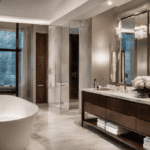
Choosing the right door is one of the most important design decisions when renovating or building a new bathroom. The bathroom door must balance style, functionality, privacy, and space efficiency.
Selecting the optimal door type and material requires careful consideration of the pros, cons, and suitability for your specific bathroom layout and design aesthetic. This comprehensive buyer’s guide examines the critical factors in choosing a bathroom door to help you make the best decision.
Key Takeaways
- Solid wood doors are the most popular bathroom choice due to their durability, moisture resistance, and versatility.
- Hollow core doors with a protective finish offer a more affordable alternative to solid wood.
- Space-saving pockets and bifold doors are great options for small bathrooms.
- Glass doors add an open, airy feel but provide less privacy.
- Barn doors bring modern style with the functionality of a sliding door.
Choosing the Right Bathroom Door Material
The material you choose for your bathroom door will impact durability, water resistance, longevity, and cost. Selecting suitable materials that can withstand moisture in a humid bathroom environment.
For bathrooms, I recommend solid wood doors. The natural durability and water-resistant properties make wood an ideal material.” – Sarah Richardson, Designer
Best Materials for Bathroom Doors
Solid Wood
- The most popular bathroom door material
- Naturally moisture-resistant
- Durable and long-lasting
- Customizable with endless style options
- Can be painted, stained, or left natural
Engineered Wood
- Affordable alternative to solid wood
- Made by laminating several layers of wood
- Resists warping from moisture
- More uniform in shape than solid wood
Fiberglass
- Strong, dent-resistant, and warp-free
- Moisture, mould, and mildew resistant
- Can mimic woodgrain patterns
- Requires minimal maintenance
- Lightweight for easy installation
Vinyl
- Budget-friendly option
- Highly water and humidity-resistant
- Easy to clean and maintain
- A large variety of colour and finish options
Composite Wood
- Made by mixing wood fibres and resins
- Durable, dense, and stable
- Resists rotting and swelling
- Easier to maintain than solid wood
Pros and Cons of Common Bathroom Door Materials
| Material | Pros | Cons |
|---|---|---|
| Solid Wood | Beautiful natural patterns, highly customizable, moisture-resistant | Expensive, requires refinishing |
| Engineered Wood | Affordable, resists warping, consistent in shape | Less water-resistant than solid wood |
| Hollow Core | Very budget-friendly, simple installation | Not durable, prone to damage |
| Fiberglass | Dent-resistant, mould/mildew resistant, low maintenance | Can show seams |
| Vinyl | Affordable, highly moisture/humidity resistant | Less aesthetic appeal |
| Composite Wood | Dense, resists rotting and swelling | Heavy, limited customization |
| Glass | Visually appealing, it makes small spaces feel bigger | Lacks privacy, needs frequent cleaning |
Design Elements for Bathroom Doors
Beyond selecting a suitable material, several design factors contribute to your bathroom door’s form and function.
Bathroom Door Styles
Flush Door
- The door fits flush into the frame/opening
- Contemporary, minimalist look
- Easier to install and paint
- Common in modern home styles
Paneled Door
- The door face has recessed panels
- Traditional aesthetic
- Can have glass panes for visual interest and privacy
- Many styles like raised, recessed, bevelled
- The door hangs from an exposed hardware track
- Slides open instead of swinging
- Adds rustic or industrial vibe
- Useful for tight spaces
- Paired doors that open outward
- It provides a symmetrical, grand look
- Allows more light into the room
- Works for wider bathroom entrances
Pocket Door
- The door slides into a cavity in the adjoining wall
- Saves floor space
- Concealed when open
- Better acoustics and noise control
Bathroom Door Opening Types
Hinge Position
The hinge placement impacts the door’s swings/opens and can optimize space efficiency.
- Standard hinge: Hinges on one side. The door opens at ~90° angle.
- Double hinged: Hinges on both sides for 180° swing. It helps open tight spaces.
- Bifold: Hinged panels fold in. Compact, space-saving.
Door Swing
Consider the swing direction based on the bathroom layout.
- Out-swinging: Opens outward. Allows more interior floor space.
- In-swinging: Opens inward. It gives more clearance in the doorway when open.
- Pocket: Slides into a cavity in the wall. It disappears when open.
Door Clearance
- Standard: ~36 inches for comfortable passage.
- ADA compliant: Minimum 32 inches for accessibility.
- Narrow space: 30 to 34 inches wide work for tight bathrooms.
Other Popular Design Features

Glass Door
- Transparent or translucent glass
- It creates an open, airy feel
- Natural light from the exterior
- Frosted glass provides some privacy
Distressed Finish
- Intentionally worn, weathered, or aged look
- Rustic, farmhouse, or cottage-style
- Often done on reclaimed wood doors
Arched Door
- The upper half forms a curved arch
- Victorian inspired aesthetic
- It can be a rounded or pointed arch
Dutch Door
- The door is divided horizontally into upper and lower sections
- Only the lower or upper portion can open
- Quaint country style
Choosing Functionality for Your Bathroom Door
The bathroom door needs to be more than just visually appealing – it also requires specific functional attributes to work well.
Space Saving Doors
Bathroom doors should be efficient to allow easy passage in and out without hogging precious space.
Pocket Doors
- Best for small, narrow bathrooms
- Slides into a cavity in the wall to open
- No floor is required for swing clearance
Bifold Doors
- Doors fold into each other in accordion-style
- Compact, space-saving operation
- Shallow depth, when available, is ideal for tight spots
Narrow Doors
- 30″ to 32″ width range for tinier bathrooms
- It still allows for comfortable passage
- Maximize remaining space
Privacy and Soundproofing
Privacy and noise control are essential for bathrooms. Look for sound insulation and visual obscuring.
- Dense core blocks sound transmission
- Offers privacy and noise control
- Prevents conversations carrying through walls
Opaque Glass Door
- Obscures shapes and outlines
- It provides privacy while allowing light
- Sandblasting, etching, or tinting glass makes it opaque
Ventilation
Proper airflow is essential in humid bathroom environments.
Louvered Door
- Horizontal slats allow air to flow through
- Improves ventilation to prevent humidity and mold
- Slats can be angled for directional control of airflow
Gap Under Door
- 1.5-2 inch gap recommended under the door
- Allows air exchange between rooms
- Use a door sweep to block light and pests
Door Organizers
Keep essentials at hand but out of sight with built-in storage solutions.
The Door Organizers
- Hooks, racks, and shelves mounted on the door back
- Use vertical space efficiently
- Convenient storage for towels, robes, accessories
Built-In Storage
- Custom cabinetry, drawers, or shelves around the door
- Seamless storage integration
- Maximize every inch of available space
Recommended Bathroom Door Types and Styles
Now that we’ve covered the critical factors surrounding your bathroom door, here are some recommended door styles and types to consider.
Best Door Types for Modern Bathrooms
Frameless Glass Door
- The sleek, minimalist look
- Unobstructed views for small space
- Frosted glass provides privacy
Pocket Door
- Discreetly hides out of sight
- The clean, streamlined aesthetic
- Space saver
Barn Door
- Rustic edge suits modern decor
- Industrial hardware makes a statement
- Saves space with slide-open function
Top Choices for Small Bathroom Doors
Bifold Door
- Extreme space saver when open
- Multiple folded panels stay compact
- Flexible door width options
Pocket Door
- Eliminates swing clearance needed
- Tucks away into a wall opening
- Optimize tiny room
Narrow Door
- 30″ size works in the most petite baths
- It still allows for comfortable passage
- Preserve remaining space
Best Doors for Cottage-Style Bathrooms
Distressed Wood Door
- Vintage charm of reclaimed wood
- The weathered patina has a worn-in appeal
- Rustic style suits cottage decor
Dutch Door
- Quaint country character
- Upper/lower sections provide privacy options
- Half door open allows light and airflow
Arched Door
- Softly rounded shape feels less imposing
- Victorian-inspired elegance and charm
- Complex carpentry adds rich detail
Unique and Statement-Making Bathroom Doors
Sliding Barn Door
- Rustic charm with modern function
- Hardware rail adds industrial edge
- It saves space and eliminates the swing radius
Glass Panel Door
- Light and open feel in bathrooms
- Narrow vertical glass panels provide privacy
- Showcase decorative tiles or wallpaper behind
Free-Standing Screen Door
- Artistic and sculptural design feature
- Used in addition to a standard door
- Made from wood, rattan, metal, or glass
For a stylistic, contemporary statement, try a tempered glass door in your modern or minimalist bathroom. The transparency provides an airy, open aesthetic while still maintaining functionality.” – Maria Killam, Design Expert
Additional Bathroom Door Considerations
Beyond the door, here are some final tips for choosing the right size, accessories, and installation.
Door Size
Pick an appropriately sized door for your bath dimensions and layout.
- Standard size: 30″ to 36″ wide x 80″ high
- Measure existing opening or frame to match
- Consider passage space and clearance
- Watch for corners, vanities, and other elements
Locks and Latches
- Privacy deadbolt lock for peace of mind
- Quiet magnetic latches won’t slam and wake you
- Occupancy lock automatically engages when you close the door
- Always consider ADA-compliant hardware
Ventilation
- Don’t block HVAC ducts or return with the door
- The gap at the bottom prevents air and moisture from being trapped
- Louvered doors enhance air circulation
Hiring a Professional
Some homeowners opt for an expert installer for their bathroom door to save time and avoid headaches.
- Carpentry skills required for proper installation
- Precision needed for hinge placement and door fitting
- Help to pick suitable sizes, accessories, and hardware
- Project management of door delivery, construction, and finishing
Is a Pocket Door a Suitable Option for a Bathroom?
When considering the pros and cons of pocket doors, it’s important to weigh their space-saving benefits against potential privacy concerns. In a bathroom, a pocket door can free up valuable square footage, but it may not provide as much sound insulation as a traditional hinged door.
Caring for Your Bathroom Door
Once your dream bathroom door is installed, follow these maintenance tips to keep it looking beautiful.
- Use gentle cleaners and avoid abrasives.
- Immediately dry any water that contacts the door.
- Periodically reseal wood doors to prevent swelling.
- Inspect hinges and hardware – lubricate and tighten as needed.
- Adjust pins and knobs to realign a sticky or dragging door.
- Replace loose, corroded, or damaged hardware.
Glass shower doors also require specialized care:
- Use a squeegee after showering to prevent water spots
- Apply rain-repellent treatments to aid cleaning
- Clean with glass cleaner and lint-free clothes
- Avoid using abrasive scouring pads or powders
With the proper selection, installation, and care, your bathroom door will function flawlessly while enhancing the beauty of your space for years to come. This guide covers all the essential factors – now the fun comes in choosing the perfect door to match your style!








